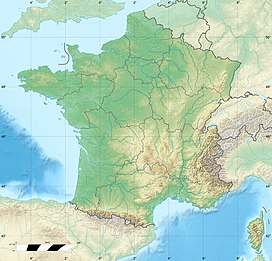User:Gildir/Les Courtes
| This is not a Wikipedia article: It is an individual user's work-in-progress page, and may be incomplete and/or unreliable. For guidance on developing this draft, see Wikipedia:So you made a userspace draft. Find sources: Google (books · news · scholar · free images · WP refs) · FENS · JSTOR · TWL |
| Les Courtes | |
|---|---|
 | |
| Highest point | |
| Elevation | 3,856 metres (12,651 ft)[1] |
| Parent peak | Mont Blanc massif |
| Coordinates | 45°55′38.7″N 7°0′12.48″E / 45.927417°N 7.0034667°E[1] |
| Geography | |
| Region | FR |
| Parent range | Graian Alps |
| Geology | |
| Mountain type | Granite |
| Climbing | |
| First ascent | First known ascent on 4 August 1876 by Henri Cordier, Thomas Middlemore, John Oakley Maund, Jakob Anderegg, Johann Jaun and Andreas Maurer; probably climbed earlier by crystal prospectors.[2][3] |
| Easiest route | Hochtour on the Glacier de Talefre to Westnordwestgrat (PD, ice up to 45°) |
Les Courtes (3,856 metres (12,651 ft))[1] is a mountain, part of the Aiguille Verte chain in the Mont Blanc massif in the French Alps. It lies in the French department of Haute-Savoie.
Location
[edit]
Les Courtes lies in the basins of the Glacier de Talèfre and the Argentière Glacier, along the ridge that leads from the Aiguille Verte through Les Droites and Les Courtes to the Aiguille de Triolet. Just west lies of the Col de la Tour des Courtes (3,720 metres (12,200 ft))[4] separated the Tour de Courtes (3,816 metres (12,520 ft)), a steep rock tower separated. Further west follows the 3,733 metres (12,247 ft)[5] high Col Droites at which the Droites connect. Southeast of the ridge above the 3,601 metres (11,814 ft) high Col de Cristaux leads to the steep gorges of the Aiguille Ravanel (3,696 metres (12,126 ft)) and the Aiguille Mummery (3,700 metres (12,100 ft)), the ridge of which leads to the Aiguille de Triolet.
The north face, toward the Argentière Glacier, is particularly demanding for mountain climbers. To the north, Les Courtes with a steep fall, interspersed with rock wall of ice, almost 1,000 meters on the Argentière Glacier from. In the south, they have a 600 meter high rock wall in the Glacier de Talèfre passes.
In addition to the main peak, the mountain has several other peaks:
- Tour des Courtes - 3,816 metres (12,520 ft)
- Épaule Ouest - 3,841 metres (12,602 ft)
- Les Courtes - highest point - 3,856 metres (12,651 ft)[1]
- Aiguille Chenavier - 3,799 metres (12,464 ft)[1]
- Aiguille Croulante - 3,765 metres (12,352 ft)
- Aiguille qui Remue - 3,724 metres (12,218 ft)[1]
Climbing opportunities
[edit]Les Courtes is frequently visited and offers tours of different character and different levels of difficulty. The normal route leads from the foot of the Aiguille du Moine located Courvercle Refuge (2687 m) on the Glacier de Talèfre and steep firn in the Col de la Tour the Courtes, of which the Westnordwestgrat leads to the summit. The route is a Hochtour with difficulty PD, ice up to 45°. Also a high tour with difficulty PD via the SE Ridge, head of the Col de Cristaux to the summit. The Col de Cristaux is the Refuge du Courvercle and lying east of Refuge d'Argentière reachable. By the steep north faces several routes that can be accessed from the Refuge d'Argentière. The Swiss driver is a pure ice route (TD, in the ice up to 70°). A combined climbing route goes over the north-east pillar (D, 50° in ice, rock IV). Through the northeast face a frequently committed pure Eisanstieg pulls with a slope up to 50°.[3]
History
[edit]The first known ascent was made on 4 August 1876 by Henri Cordier, Thomas Middlemore, John Oakley Maund, Jakob Anderegg, Johann Jaun and Andreas Maurer by the Cordier route on the north side.[2] The first ascent was probably already made years earlier by crystal prospectors[6] on the southwest side. The first ascent of today's normal route was made by O. Schuster and A. Swaine on 17 August 1897. The first ascent of the north face was made on 12 August 1930 by P. Chevalier and G. Labour. In the late 1930s, the Swiss driver (July 1938 by C. Cornaz and R. Mathey) and the north-east pillar (July 1939 by E. Frendo, A. Tournier, R. Jonquière, A. Mallol and M. Villarem) were first ascended.[3]
Refuges
[edit]- Refuge d'Argentière (2,771 metres (9,091 ft))
- Refuge du Courvercle (2,687 metres (8,816 ft))
References
[edit]- ^ a b c d e f "Les Courtes". Camptocamp-Association. Retrieved 4 February 2013.
- ^ a b Ballu, Yves (1997). Les alpinistes. Glénat.
- ^ a b c Eberlein, Hartmut (2000). Gebietsführer Mont-Blanc-Gruppe. München: Bergverlag Rother. pp. 338 ff.
- ^ lt. Institut géographique national Maßstab 1:25000. Swisstopo LK25 gibt eine Höhe von 3,711 m above the sea an.
- ^ lt. Institut géographique national Maßstab 1:25000. Swisstopo LK25 gibt eine Höhe von 3,720 m above the sea an.
- ^ Frison-Roche, Roger; Jouty, Sylvain (1996). A History of Mountain Climbing. Trans. Deke Dusinberre. Paris, New York: Flammarion. p. 23. ISBN 2-08-013622-4. LCCN 96-85980. OCLC 36019037.
You can help expand this article with text translated from the corresponding article in French. (February 2013) Click [show] for important translation instructions.
|
You can help expand this article with text translated from the corresponding article in German. (February 2013) Click [show] for important translation instructions.
|
You can help expand this article with text translated from the corresponding article in Italian. (February 2013) Click [show] for important translation instructions.
|
{{cite book}}: Cite has empty unknown parameter: |total_pages= (help)External links
[edit]
Category:Alpine Three-thousanders
Category:Mountains of Haute-Savoie
Category:Mountains of the Alps





